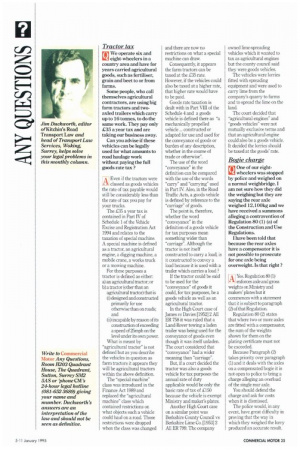Tractor tax
Page 37

If you've noticed an error in this article please click here to report it so we can fix it.
We operate six and eight-wheelers in a country area and have for years carried agricultural goods, such as fertiliser, grain and beet to or from farms.
Some people, who call themselves agricultural contractors, are using big farm tractors and twoaxled trailers which carry up to 16 tonnes, to do the same work. They pay only £35 a year tax and are taking our business away.
Can you advise if these vehicles can be legally used for what amounts to road haulage work without paying the full goods rate tax ?
AEven if the tractors were classed as goods vehicles the rate of tax payable would still be considerably less than the rate of tax you pay for your trucks.
The £35 a year tax is contained in Part IV of Schedule 1 of the Vehicle Excise and Registration Act 1994 and relates to the taxation of special machine. A special machine is defined as a tractor, an agricultural engine, a digging machine, a mobile crane, a works truck or a mowing machine.
For these purposes a tractor is defined as either: a) an agricultural tractor; or b) a tractor (other than an agricultural tractor) that is (i) designed and constructed primarily for use otherwise than on roads; and (ii) incapable by reason of its construction of exceeding a speed of 25mph on the level under its own power.
What is meant by "agricultural tractor" is not defined but as you describe the vehicles in question as farm tractors it appears they will be agricultural tractors within the above definition.
The "special machine" class was introduced in the Finance Act 1989 and replaced the "agricultural machine" class which contained restrictions on what objects such a vehicle could haul on a road. Those restrictions were dropped when the class was changed and there are now no restrictions on what a special machine can draw.
Consequently, it appears the farm tractors can be taxed at the £35 rate. However, if the vehicles could also be taxed at a higher rate, that higher rate would have to be paid.
Goods rate taxation is dealt with in Part VIII of the Schedule 4 and a goods vehicle is defined there as "a mechanically propelled vehicle ... constructed or adapted for use and used for the conveyance of goods or burden of any description, whether in the course of trade or otherwise".
The use of the word "conveyance" in the definition can be compared with the use of the words "carry" and "carrying" used in Part IV. Also, in the Road Traffic Acts, a goods vehicle is defined by reference to the "carriage" of goods.
The point is, therefore, whether the word "conveyance" in the definition of a goods vehicle for tax purposes mean something wider than "carriage". Although the tractor is not itself constructed to carry a load, is it constructed to convey a load because it is used with a trailer which carries a load ?
If the tractor could be said to be used for the "conveyance" of goods it could, for tax purposes, be a goods vehicle as well as an agricultural tractor.
In the High Court case of James vs Davies [1952] 2 All ER 758 it was ruled that a Land-Rover towing a laden trailer was being used for the conveyance of goods even though it was itself unladen. The court considered that "conveyance" had a wider meaning than "carriage".
But, if a court decided the tractor was also a goods vehicle for tax purposes the annual rate of duty applicable would be only the basic rate of tax of £150 because the vehicle is exempt Ministry and maker's plates.
Another High Court case on a similar point was Berkshire County Council vs Berkshire Lime Co. [1953] 2 All ER 799. The company owned lime-spreading vehicles which it wanted to tax as agricultural engines but the county council said they were goods vehicles.
The vehicles were lorries fitted with spreading equipment and were used to carry lime from the company's quarry to farms and to spread the lime on the land.
The court decided that "agricultural engines" and "goods vehicles" were not mutually exclusive terms and that an agricultural engine could also be a goods vehicle. It decided the lorries should be taxed at the goods' rate.












































































